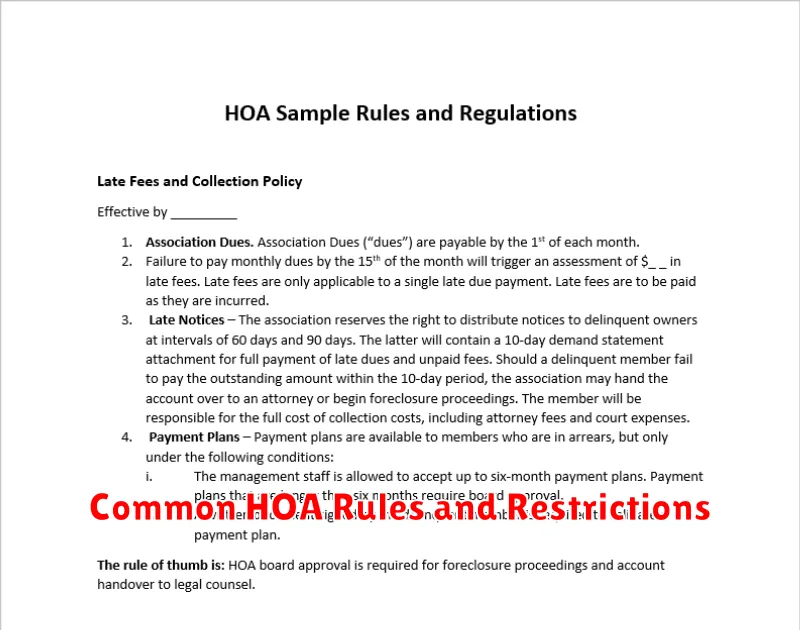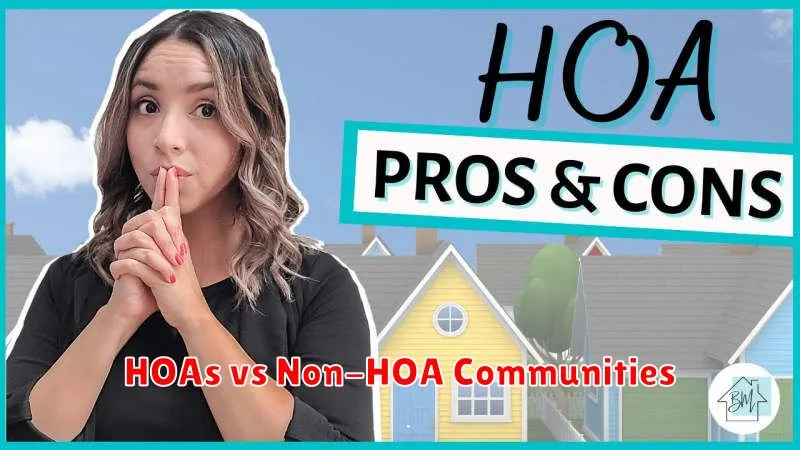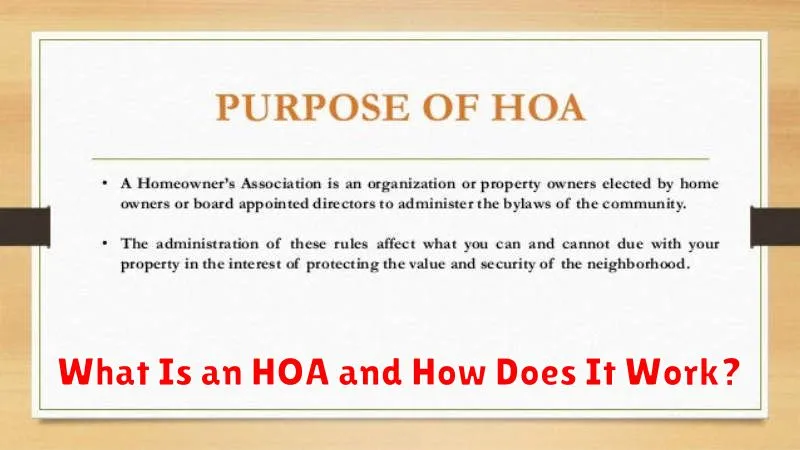Understanding the intricacies of a Homeowners Association (HOA) is crucial for anyone considering purchasing property within a planned community. An HOA is a governing body that manages the shared spaces and common areas of a residential development. This includes elements such as swimming pools, landscaping, and roadways. HOAs also enforce community rules and regulations, ensuring a consistent standard of living for all residents. This introductory guide will demystify the concept of an HOA, exploring its functions and explaining how it operates to maintain the harmony and value of your prospective neighborhood. Learn about the benefits and responsibilities of HOA membership, as well as the financial implications, including HOA fees and assessments.
Whether you are a first-time homebuyer or a seasoned investor, navigating the world of HOAs requires a comprehensive understanding of their structure and authority. This article will delve into the roles and responsibilities of the HOA board, the governing documents like the CC&Rs (Covenants, Conditions, and Restrictions), and how these elements impact your property rights. Discover the mechanisms for resolving disputes within an HOA and gain valuable insights into making informed decisions about living in an HOA-managed community. Understanding how an HOA works is essential for ensuring a positive and harmonious living experience.
Definition of a Homeowners Association
A homeowners association (HOA) is a private organization that governs a planned community, condominium complex, or subdivision. HOAs are typically established by real estate developers for the purpose of managing, maintaining, and selling properties within the development. They enforce community rules and collect dues from residents to fund these activities. The governing documents establishing the HOA’s power are generally recorded in the land records where the property is located, and buyers are required to agree to abide by these documents as a condition of their purchase.
The primary function of an HOA is to uphold and enforce the community’s covenants, conditions, and restrictions (CC&Rs). These regulations dictate aspects of the community’s appearance and how residents can use their property. Examples include architectural guidelines (like house color or landscaping), parking rules, noise restrictions, and pet regulations. By enforcing the CC&Rs, HOAs aim to maintain property values, ensure consistent aesthetic standards, and promote harmonious living within the community. Membership in the HOA is mandatory for all property owners within the development, and they are bound by the HOA’s rules and regulations.
HOA fees, typically paid monthly or annually, are used to cover the costs associated with managing and maintaining common areas. These may include parks, swimming pools, clubhouses, landscaping, private roads, and security. The fees also support administrative expenses such as insurance, legal counsel, and accounting services. The amount of HOA fees varies based on the community’s amenities and services provided. Failure to pay HOA fees can result in liens being placed against the property, fines, and even foreclosure in some cases.
What HOA Fees Typically Cover
Homeowners association (HOA) fees are recurring payments made by residents of planned communities to cover shared expenses and maintain common areas. These fees contribute to the upkeep and operation of amenities and services that enhance the community. The exact breakdown varies between HOAs, but common inclusions are maintenance of landscaping, swimming pools, and fitness centers. Additionally, fees often contribute to trash removal, snow plowing, street lighting, and security services.
Beyond the tangible amenities, HOA fees often cover administrative costs. These include the management and enforcement of community rules and regulations outlined in the HOA’s governing documents. This encompasses tasks like handling homeowner inquiries, coordinating repairs, and ensuring adherence to established standards for property appearance. Furthermore, a portion of the fees may be allocated towards reserve funds, which are crucial for addressing large-scale repairs or replacements in the future, such as roof repairs or road resurfacing. This helps protect property values and ensures long-term financial stability for the community.
It’s crucial to understand what your specific HOA fees cover. Request a detailed breakdown from the HOA management to comprehend how your contributions are utilized. Transparency in fee allocation fosters trust between residents and the HOA, promoting a well-maintained and harmonious community environment.
Benefits of HOA-Regulated Communities
Living in a Homeowners Association (HOA) regulated community offers several advantages. HOAs typically maintain common areas like parks, pools, and landscaping, relieving homeowners of these responsibilities. This often results in a more aesthetically pleasing and well-maintained neighborhood. Furthermore, HOAs frequently provide amenities such as fitness centers, clubhouses, and security services, enhancing residents’ quality of life. Consistent property upkeep through enforced regulations can also help protect and even increase property values.
HOA regulations promote community harmony by establishing clear expectations for property maintenance and resident behavior. These rules can cover aspects such as landscaping, exterior paint colors, noise levels, and pet restrictions. By setting these standards, HOAs aim to prevent disputes between neighbors and maintain a consistent community appearance. This predictability and structure can be particularly attractive to some homeowners seeking a stable and well-ordered living environment.
While HOA fees represent an added expense, they often cover services that homeowners would otherwise have to pay for individually. This can include trash removal, snow plowing, and exterior building maintenance. By pooling resources, HOAs can often negotiate better rates for these services. Additionally, the long-term benefits of maintained property values and community amenities can outweigh the cost of HOA fees for many homeowners.
Common HOA Rules and Restrictions

Homeowners’ Associations (HOAs) establish rules and restrictions to maintain property values and create a harmonious living environment. These regulations, outlined in the HOA’s governing documents (CC&Rs), cover a range of issues. Commonly regulated areas include architectural modifications such as paint colors, landscaping, and fence styles. Pet restrictions often limit the number, size, or breed of animals allowed. Parking regulations address designated spaces, guest parking, and street parking limitations. Noise levels are typically controlled, especially during certain hours, to prevent disturbances. Understanding and adhering to these rules is crucial for all residents within an HOA community.
Exterior maintenance is another area frequently covered by HOA rules. This can encompass upkeep of yards, including lawn care, tree trimming, and weed control. The appearance of homes, including the condition of paint, siding, and roofs, may also be subject to regulations. These rules aim to prevent neglect and ensure a consistent aesthetic throughout the community. Some HOAs may also regulate the use of common areas such as pools, clubhouses, and fitness centers, establishing rules for access, hours of operation, and guest privileges. These shared amenities are intended for the enjoyment of all residents, and the rules help maintain order and fairness.
Beyond the common examples, HOAs can implement other rules based on the specific needs of their community. These might involve restrictions on trash disposal, antennae installation, or even the display of holiday decorations. It is vital for homeowners to thoroughly review their HOA’s governing documents to understand all applicable rules and regulations. Failure to comply can lead to fines, legal action, and even liens being placed on the property. Open communication with the HOA board is encouraged to address any questions or concerns regarding the rules and their enforcement.
How to Evaluate an HOA Before Buying
Before purchasing a property governed by a Homeowners Association (HOA), it’s crucial to thoroughly evaluate the association to ensure it aligns with your lifestyle and financial expectations. Start by reviewing the HOA’s governing documents, including the CC&Rs (Covenants, Conditions, and Restrictions), bylaws, and meeting minutes. These documents outline the rules and regulations, financial health of the HOA, and any ongoing disputes or planned projects. Pay close attention to restrictions that could impact your lifestyle, such as pet limitations, landscaping requirements, or limitations on rentals.
Next, assess the HOA’s financial stability. Review the reserve funds, budget, and any planned assessments. A healthy reserve fund is essential for covering unexpected repairs and maintenance. Inquire about the history of assessments and the likelihood of future increases. Understanding the HOA’s financial standing will help you avoid unexpected costs and ensure the association can properly maintain the community.
Finally, consider the HOA’s management and communication style. Attend an HOA meeting to observe the dynamics and how concerns are addressed. Talk to current residents about their experiences with the HOA’s responsiveness and enforcement of rules. A well-managed HOA should be transparent, communicative, and responsive to the needs of its residents. This will contribute significantly to your overall satisfaction with the community.
Can You Opt Out of HOA Fees?
Generally, no, you cannot opt out of HOA fees if your property is located within a homeowners association. HOA fees are mandatory and tied to property ownership within the HOA’s jurisdiction. These fees fund the maintenance and operation of common areas, amenities, and services provided to residents. By purchasing a property within an HOA, you agree to abide by its rules and regulations, including the payment of assessments.
There are very limited exceptions, such as if the HOA is improperly established or if your property is specifically exempted in the governing documents. Challenging HOA fees requires careful review of the HOA’s governing documents (CC&Rs) and potentially legal counsel. It’s important to understand that simply disagreeing with how the fees are spent is typically not sufficient grounds for refusal to pay.
Failure to pay HOA fees can lead to serious consequences, including liens against your property, foreclosure, and lawsuits. It’s crucial to understand your obligations before purchasing a property governed by an HOA.
What Happens if You Violate HOA Rules
Homeowners Associations (HOAs) have the power to enforce their rules and regulations, and consequences for violations can range from warnings to fines and even legal action. It all starts with a notice of violation outlining the infraction. Ignoring this notice is not recommended, as it can lead to escalating penalties. HOAs typically have a clearly defined process for handling violations, which is outlined in their governing documents. It’s crucial to familiarize yourself with these documents to understand your rights and responsibilities.
If the violation isn’t rectified after the initial notice, you can expect to face fines. These fines can increase significantly if the problem persists. Beyond monetary penalties, some HOAs have the authority to suspend privileges, such as access to common amenities like pools or clubhouses. In extreme cases, an HOA might place a lien on your property or even pursue legal action to compel compliance.
The best course of action if you receive a violation notice is to communicate with the HOA promptly. Often, a simple conversation can clarify the issue and lead to a resolution. Understanding the rules and maintaining open communication with the HOA are key to avoiding potential conflicts and penalties.
HOA Meeting Participation
Attending your Homeowners Association (HOA) meetings is a crucial aspect of responsible homeownership. These meetings provide valuable insight into the financial health of the community, upcoming projects, and changes to rules and regulations. Active participation allows homeowners to voice their opinions, concerns, and contribute to decisions that directly impact their property and community.
Meetings often cover topics like budget reviews, maintenance plans, and community improvements. Being informed about these matters empowers homeowners to make educated decisions regarding their investment. Furthermore, attending meetings fosters a stronger sense of community and allows for open communication between residents and the HOA board.
By actively engaging in HOA meetings, homeowners can contribute to a more transparent and responsive association. Your participation makes a difference.
Understanding Reserve Funds
A reserve fund is a savings account set aside by individuals, businesses, or governments to cover unexpected expenses or financial obligations. These funds provide a cushion against unforeseen circumstances, allowing entities to weather financial storms without incurring significant debt or disrupting operations. Properly managed reserve funds contribute to long-term financial stability and demonstrate responsible fiscal management.
For individuals, a reserve fund is often referred to as an emergency fund. This money is typically used for unexpected job loss, medical emergencies, or necessary home repairs. For businesses, reserve funds can be used to cover operational expenses during slow periods, invest in new opportunities, or manage economic downturns. Governments utilize reserve funds to respond to natural disasters, fund infrastructure projects, or address budget deficits.
The appropriate size of a reserve fund depends on the specific needs and circumstances of the entity. Individuals are often advised to have three to six months of living expenses saved. Businesses and governments base their reserve fund needs on factors such as revenue volatility, potential liabilities, and long-term financial goals. Regular contributions and prudent management are essential for maintaining adequate reserve funds and ensuring their effectiveness in times of need.
HOAs vs Non-HOA Communities

Choosing between a community with a Homeowners Association (HOA) and one without involves weighing the pros and cons of each. HOAs offer benefits like maintained common areas (parks, pools, etc.), consistent property aesthetics thanks to enforced rules, and sometimes even amenities like trash removal or snow plowing. These benefits come at a cost, however, in the form of HOA fees, which can be substantial, and restrictions on property modifications, landscaping, and even things like paint colors. Living in an HOA community means abiding by the established rules and regulations.
Non-HOA communities offer greater freedom and flexibility. Homeowners are generally free to make changes to their properties as they see fit (within local ordinances, of course). There are no HOA fees to pay. The trade-off is the potential for inconsistent property maintenance, less community uniformity, and often the responsibility for handling tasks like landscaping and snow removal individually. Disputes between neighbors regarding property issues might require more direct intervention without an HOA to mediate.
Ultimately, the best choice depends on your priorities and lifestyle. Consider whether you value the convenience and amenities of an HOA-managed community or prefer the autonomy and freedom of a non-HOA neighborhood. Think about your budget, tolerance for rules, and desired level of involvement in community affairs when making your decision.

